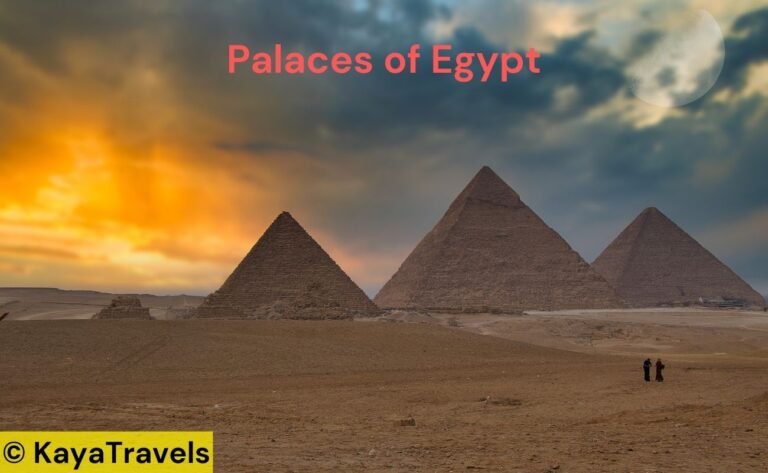Nestled in the heart-strewn hills of Luxor, the Valley of the Kings stands as a gateway to the past glories of Ancient Egypt. Here, under the watchful eye of the Theban Mountain, lie the tombs of the most powerful pharaohs of the New Kingdom.
This archaeological treasure trove has beckoned to both scholars and travellers alike, each tomb offering a map to understanding the beliefs, rituals, and the very essence of a civilization that once reigned supreme along the banks of the Nile.
Your journey into this ancient royal necropolis will reveal over 60 tombs, including the resting places of legendary figures such as Tutankhamun and Ramses II.
These underground chambers, intricately adorned with hieroglyphics and paintings, provide a vivid narrative of the lives and accomplishments of the pharaohs and the gods they worshipped.
As you explore, you’ll see that every tomb is a world of its own, a singular map etched in stone and color that charts the passage from this life to the next.
Planning a visit to this awe-inspiring site requires more than just a map; it demands an understanding of its historical significance and the stories behind its construction.
The tombs here were not merely final resting places but carefully crafted masterpieces designed to honour the pharaohs and assure their transcendence into the afterlife.
The Valley of the Kings, therefore, is not just a physical location—it’s a passage through time, an enduring testament to Egypt’s enduring allure and the mystery that still shrouds much of its past.
Exploring the Tombs
“Uncover the past in every step” is an adage that rings true as you journey through the labyrinthine tombs of the Valley of the Kings.
This ancient cemetery houses the resting places of pharaohs and powerful nobles, offering a glimpse into Egypt’s storied history.
Tomb Complexes and Their Significance
The Valley of the Kings, known in ancient times as Thebes, was a grand burial ground for Egypt’s greatest rulers. Each tomb complex is a network of intricately carved corridors and chambers.
KV, short for King’s Valley, designates the tomb number within this vast archaeological site. The burial sites were sacred spaces intended to honour the deceased and guide them into the afterlife, laden with treasures, elaborate mummies, and sarcophagi.
Notable rulers such as Tutankhamun (KV62), Ramses II, and Seti I were interred here, with their final resting places reflecting their lifetime achievements and eternal glory.
Excavation and discovery efforts, such as those led by Howard Carter, have unveiled stunning artefacts and intricate hieroglyphics that reveal much about burial rites and the Egyptian belief in the afterlife.
Notable Tombs and Discoveries
Among the numerous tombs, some stand out due to their historical significance and the treasures they held.
- Tomb of Tutankhamun (KV62): Discovered by Howard Carter in 1922, this tomb is famed for its pristine condition and the wealth of artefacts it contained.
- Tomb of Seti I (KV17): One of the longest and deepest in the valley, featuring some of the most beautiful mural decorations.
- Tomb of Horemheb (KV57): Distinguished by its depth and the vibrant colours in the burial chamber.
- Tomb of Ay (KV23): Ay, successor to Tutankhamun, his tomb affords insight into the transition period following the famous young king’s death.
These tombs hint at the life of their occupants and the people of their time. Over the centuries, however, most tombs were subject to raids by tomb robbers, who looted many of the invaluable items left with the departed.
Theban Mapping Project offers a detailed exploration aid, enriching your understanding of the site’s history and layout reinforcing the importance of preservation and study of this ancient wonder.
Unearth the mysteries and revisit the grandeur of Egypt’s illustrious ancestors as you walk through these corridors of antiquity. Your connection to the past is but a visit away.
Planning Your Visit
When visiting the Valley of the Kings, purchasing an entrance ticket and choosing a suitable tour can enhance your experience; understanding how to navigate transportation is vital, and knowing a few visitor tips can make your trip both enjoyable and efficient.
Tickets and Tours
To explore the Valley of the Kings, you’ll need an entrance ticket, which grants access to the main area and a select number of tombs. Some tombs require an additional ticket.
It’s wise to book a guided tour from Luxor for a more informative visit, as guides can share the history and significance of this ancient burial site. You can often purchase tickets at the visitor centre or in advance through tour operators.
- Standard Ticket: Access to three tombs.
- Additional Tombs: Tickets for Tutankhamun, Seti I, and Ramses VI are available separately.
Transportation and Accessibility
The Valley of the Kings is located on the west bank of the Nile, near Luxor. You can reach the valley by taxi, ferry, or on a tour bus from Luxor. If you’re in Cairo, consider taking a train or a domestic flight to Luxor before heading to the valley.
- Taxi: Agree on the fare before the trip.
- Ferry: Cross the Nile from Luxor and take a taxi or bike to the valley.
- Tour Bus: Often included in guided tours.
Visitor Tips and Information
Before you begin your exploration, here are some essentials to ensure a smooth visit:
- Photography: Inside the tombs, photography is often prohibited unless you purchase a photography pass.
- Climate: Be prepared for the heat, especially during midday. Bring water, sunscreen, and a hat.
- Facilities: Restrooms are at the entrance and near the visitor centre. It’s wise to use the facilities at the visitor centre as they’re cleaner.
By following these straightforward tips and planning, your visit to the Valley of the Kings will be a memorable journey into ancient Egypt’s history.






